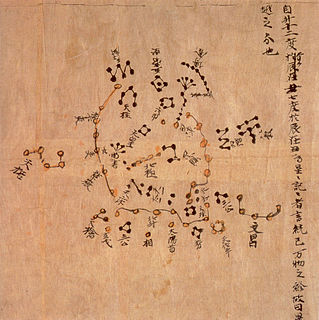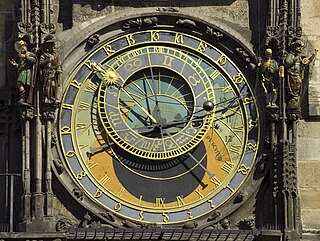 W
WAstronomy in China has a long history stretching from the Shang Dynasty, being refined over a period of more than 3,000 years. The Ancient Chinese people have identified stars from 1300BCE, as Chinese star names later categorized in the twenty-eight mansions have been found on oracle bones unearthed at Anyang, dating back to the mid-Shang Dynasty. The core of the "mansion" (xiù:宿) system also took shape around this period, by the time of King Wu Ding.
 W
WChinese star maps are usually directional or graphical representations of Chinese astronomical alignments. Throughout the history of China, numerous star maps have been recorded. This page is intended to list or show the best available version of each star map. Star catalogs are also listed. For academic purposes, related star maps found in East Asia outside China are also listed.
 W
WAn astronomical clock, horologium, or orloj is a clock with special mechanisms and dials to display astronomical information, such as the relative positions of the sun, moon, zodiacal constellations, and sometimes major planets.
 W
WThe modern constellation Coma Berenices lies across one of the quadrants symbolized by the Azure Dragon of the East, and Three Enclosures, that divide the sky in traditional Chinese uranography.
 W
WChinese records of comets are the most extensive and accurate in existence from the ancient and medieval periods, and stretch back across three millennia. Records exist at least as far back as 613 BC, and records may have been kept for many centuries before this. There are continuous records all the way through to the nineteenth century, using substantially consistent methods throughout. Chinese data accuracy is unsurpassed in the ancient world and was not overtaken by Western accuracy until the fifteenth century or, in some respects, not until the twentieth century.
 W
WThe Divination by Astrological and Meteorological Phenomena, also known as Book of Silk is an ancient astronomy silk manuscript compiled by Chinese astronomers of the Western Han Dynasty and found in the Mawangdui of Changsha, Hunan, China in 1973. It lists 29 comets that appeared over a period of about 300 years.
 W
WThe Dream Pool Essays was an extensive book written by the Chinese polymath and statesman Shen Kuo (1031–1095), published in 1088 during the Song dynasty (960–1279) of China. Shen compiled this encyclopedic work while living in forced retirement from government office, naming the book after his private estate near modern Zhenjiang, Jiangsu province. The Dream Pool Essays was heavily reorganized in reprint editions by later Chinese authors from the late 11th to 17th centuries. In modern times it has been translated from Chinese into several languages. These include English, German, French, and Japanese translations.
 W
WThe Dunhuang map or Dunhuang Star map is one of the first known graphical representations of stars from ancient Chinese astronomy, dated to the Tang Dynasty (618–907). Before this map, much of the star information mentioned in historical Chinese texts had been questioned. The map provides a graphical verification of the star observations, and are part of a series of pictures on one of the Dunhuang manuscripts. The astronomy behind the map is explained in an educational resource posted on the website of the International Dunhuang Project, where much of the research on the map has been done. The Dunhuang Star map is to date the world's oldest complete preserved star atlas.
 W
WIn Chinese astronomy, a guest star is a star which has suddenly appeared in a place where no star had previously been observed and becomes invisible again after some time. The term is a literal translation from ancient Chinese astronomical records.
 W
WChinese records of comets are the most extensive and accurate in existence from the ancient and medieval periods, and stretch back across three millennia. Records exist at least as far back as 613 BC, and records may have been kept for many centuries before this. There are continuous records all the way through to the nineteenth century, using substantially consistent methods throughout. Chinese data accuracy is unsurpassed in the ancient world and was not overtaken by Western accuracy until the fifteenth century or, in some respects, not until the twentieth century.
 W
WLéopold de Saussure was a Swiss-born French sinologist, pioneering scholar of ancient Chinese astronomy, and officer in the French navy. After a naval career which took him to Indochina, China, and Japan, he left the service and devoted the rest of his life to scholarship. He was most famous for his studies of ancient Chinese astronomy.
 W
WSiming refers to a Chinese deity or deified functionary of that title who makes fine adjustments to human fate, with various English translations. Siming is both an abstract deity and a celestial asterism.
 W
WPhi Draconis is a fourth-magnitude variable star in the constellation Draco. It has the Flamsteed designation 43 Draconis. It is also a triple star system where the brightest component is a chemically peculiar Ap star.